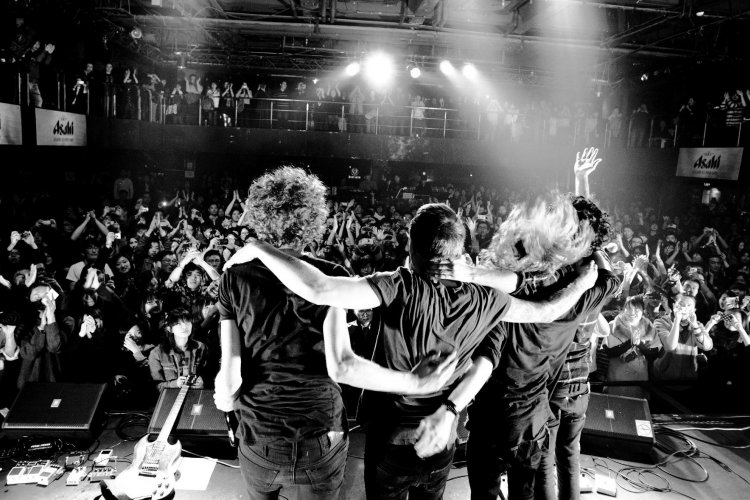Shanghai's Past As Seen Through Photos
As good Beijingers, we all ostensibly harbor a loathing of Shanghai. (Those damn Shenhua beat our beloved Guoan -- excuse me, I mean champions Guoan -- 3-2 on Saturday.) But hard as it is to admit, it's impossible not to be impressed by our cousin city to the south, which boasts heaving monuments to modernity, world-class restaurants and bars, homely cafes and diners, intimate communities that formed organically, panoplies of local flavor and opportunities galore. Jay-Z and Alicia Keys' lyric, "concrete jungle where dreams are made of," might as well use Shanghai as the refrain.
H.S. Liu and Karen Smith's newest coffee-table book, Shanghai: A History in Photographs, 1842-Today, impressively renders the city in all its layers, weaving a pictorial history that begins from the 1842 Treaty of Nanking and ends in modern time. Tonigth (Wednesday, May 26) starting at 7:30 pm at the Bookworm (RMB 30), Liu and Smith will talk all about their book's subject, the "Paris of the East."
Commissioned by the Shanghai Corporate Pavilion, Liu and Smith were natural choices to edit this book. Liu is a Pulitzer Prize-winning photojournalist whose previous works, China After Mao and China: Portrait of a Country, earned high acclaim. Smith is a curator who specializes in Chinese contemporary art. In Shanghai: A History in Photographs, we get 400-some images from well-known photographers and private collectors alike -- some never-before-published -- that, according to Smith, weave a "history that is meaningful to local Shanghainese and Chinese people, as well as a foreign reader." We recently spoke with her about this project.
Do you think Shanghai has changed more in the last 20 years than Beijing has?
In some ways, yes, because Shanghai was even more of a sleepy backwater when I first arrived in China (in 1990) than Beijing was. Beijing's always been big, it has scale, but Shanghai felt small, claustrophobic, labyrinthine, with lots of small streets, lots of people. The first couple of times I went there was in the summer and it was particularly hot, and I ended up walking around neighborhoods where people lived in very tiny spaces, so everybody lived out in the streets in the summertime.
I've always heard that a lot of Shanghai's neighborhoods arose organically, they weren't centrally planned. You'd have the culture of individual neighborhoods.
One of the things that Shanghai does is they've preserved an awful lot more of their houses. But everything's relative. Shanghai had a lot more of these kind of classical art-deco style buildings. You do see them intact, and I think partly the romance of the heritage surrounding Shanghai is the reason why people have put such a lot of money into restoring the buildings on the Bund.
Shanghai and Beijing seem to have such a natural rivalry -- do you feel that?
I think people do simply because Beijing is the capital, so there was this idea that Beijing should be China's leading city. But Shanghai has this very particular past which gives it its romance. And there is this idea that in Shanghai, you go to have a good time; (you come to) Beijing to see the cultural artifacts, to see the Chinese history.
I've always thought Beijing had more culture.
Yes, I think that's what a lot of people believe. And yet, when we were in Shanghai doing the book presentation, people would say, You haven't got much culture in here, you have a lot of smiling people but not culture, are you trying to say that Shanghai doesn't have a culture? And it's like, well, no...
Shanghai's culture is this unseen culture, which is that same mystique you get associated with Paris... this idea that there is something about eating a croissant on the sidewalk with a cup of coffee, and that's the culture of France in a way, and it's that sort of culture that we see in Shanghai.
In selecting the photos, what was the dominant criterion?
They were all really about people and daily life, predominantly. We have very few that are not centered on people. Just to show all aspects of life as lived in Shanghai.
That must have been difficult, seeing how Shanghai encompasses every aspect.
I hope everything's covered in here, more or less, from the artists to the ordinary people going through their daily routines.
When foreign people or visitors go to Shanghai, including the Chinese, they tend to go to those areas dominated by the Bund, so they get a particular vision of what Shanghai is, whereas behind the Bund it's quite a different world for a lot of ordinary people.
Karen Smith and H.S. Liu, editors of Shanghai: A History in Photographs, 1842-Today, are speaking at The Bookworm tonight (Wednesday, May 26) starting at 7:30 pm (RMB 30).






